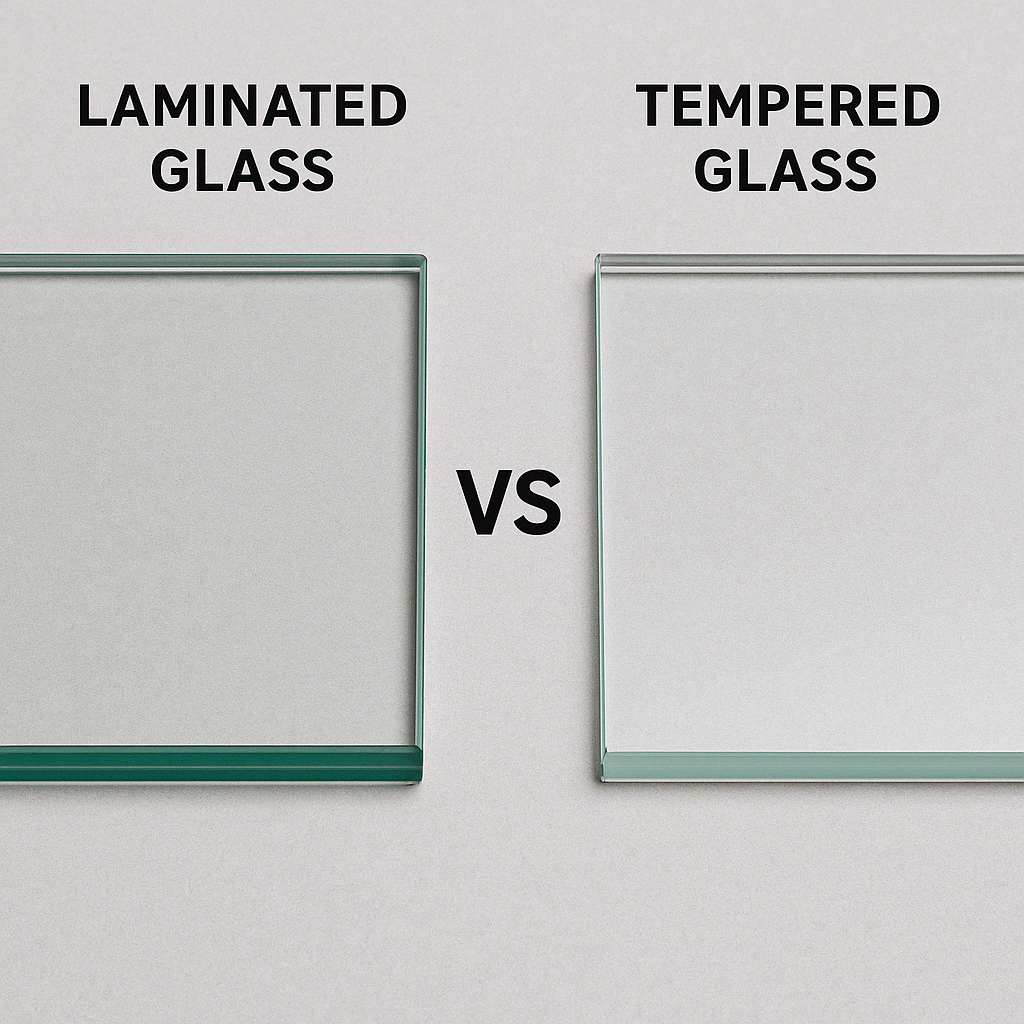Discover the differences between laminated glass vs tempered glass, including their composition, uses, safety, and design. Learn how to avoid issues like composition imbalance, inconsistent lighting, and flat perspective in glass applications.
Understanding the distinction between laminated glass vs tempered glass is crucial for architects, homeowners, and builders seeking optimal safety, performance, and aesthetics in construction. Both types of safety glass serve specific roles and are regulated under stringent glazing standards, but their composition, functionality, and use cases differ significantly.
This guide dives deep into what they are, how they are made, and which is better depending on the application.
What is Laminated Glass?
Laminated glass is a type of safety glass made by bonding two or more layers of glass with an interlayer, typically polyvinyl butyral (PVB) or ethylene-vinyl acetate (EVA). This interlayer holds the layers together even when broken, preventing dangerous shards from scattering.
This structure ensures that glass laminated panes remain intact upon impact, making them ideal for environments that require enhanced security, sound insulation, and UV filtering.
Common Uses of Laminated Glass:
- Car windshields
- Skylights and overhead glazing
- Bank teller screens and jewelry displays
- Hurricane-resistant windows
- Noise-reduction partitions
Key Advantages:
- Holds together when shattered
- UV protection and sound insulation
- Higher security against break-ins
What is Tempered Glass?
Tempered glass, also known as toughened glass, is produced by heating standard glass to extreme temperatures (over 600°C) and then rapidly cooling it. This process compresses the surface, increasing its strength by 4 to 5 times over regular float glass.
When broken, tempered glass fractures into small, rounded pieces, significantly reducing the risk of injury.
Typical Applications of Tempered Glass:
- Shower enclosures
- Tabletops and shelves
- Mobile phone screens
- Building windows and curtain walls
- Oven doors and cooktops
Key Advantages:
- High thermal resistance
- Stronger than standard and laminated glass
- Breaks safely without sharp shards
Laminated Glass vs Tempered Glass: Key Differences
| Feature | Laminated Glass | Tempered Glass |
|---|---|---|
| Composition | Two or more layers with interlayer | Single layer heat-treated glass |
| Breakage Behavior | Cracks but stays in place | Shatters into blunt fragments |
| Sound Insulation | High due to interlayer | Lower compared to laminated |
| UV Protection | Yes, filters harmful rays | Limited or none |
| Cost | Higher due to multilayer composition | Lower cost option |
| Safety Level | Better for security and glass retention | Good for injury prevention |
| Thickness & Weight | Heavier due to layers | Lighter for the same size |
| Cutting & Modification | Easier before lamination | Cannot be cut after tempering |
How Laminated Glass Is Manufactured
The process starts with two or more panes of annealed glass. Between these panes, a PVB or EVA interlayer is placed. The stack is then pressed under heat in an autoclave, bonding them into a single unit.
Laminated glass manufacturers often customize:
- Thickness
- Tint or color
- Acoustic or solar performance
- Bullet resistance or forced entry resistance
This versatility makes it suitable for soundproof studios, secure storefronts, and even museum displays.
How Tempered Glass Is Made
Tempered glass is manufactured through a thermal tempering process:
- Glass is heated uniformly.
- It’s rapidly cooled using high-pressure air jets.
- The surface compresses while the core remains in tension.
This difference in internal stress results in enhanced impact resistance and a safer break pattern. Once tempered, however, the glass cannot be re-cut or altered—doing so will cause it to shatter.
Which One Should You Choose?
When comparing tempered glass vs laminated glass, the right choice depends on your needs:
- Choose laminated glass if you require:
- Noise reduction
- UV protection
- Security (forced entry, hurricane resistance)
- Safety glass for overhead installations
- Choose tempered glass if your priority is:
- Heat resistance
- Strength in frameless applications
- Safer breakage for indoor partitions
- Cost-effective safety compliance
Design Considerations: Light, Balance, and Perspective
In architecture and interior design, poor glass selection can lead to issues like:
- Composition imbalance: Visual asymmetry due to mixed glass types
- Inconsistent lighting: Mismatched tint or thickness affects light penetration
- Flat perspective: Lack of depth or reflection distorts spatial perception
Careful selection between laminated and tempered glass helps prevent these issues. For example, laminated glass offers subtle tint control and multiple reflections, while tempered glass excels in clarity and minimal distortion.
Related Glass Terms and Alternatives
- Annealed glass: Basic untreated glass, used in non-safety applications.
- Double-glazed glass: Two panes with air or gas in between, often with tempered or laminated units.
- Heat-strengthened glass: Less strong than tempered but more resistant than standard float glass.
- Bullet-resistant glass: Typically a multi-layer laminated glass solution.
Conclusion
In summary, both laminated and tempered glass have their strengths, but their differences make each suitable for distinct environments. Whether you prioritize security, clarity, thermal resistance, or noise reduction, understanding these differences allows better decision-making in residential, commercial, and automotive applications.
For more in-depth insights, consult certified laminated glass manufacturers or your local building codes before installation.
More about laminated glass, visit https://theallglass.com/laminated-glass-get-to-know-what-is-it/

